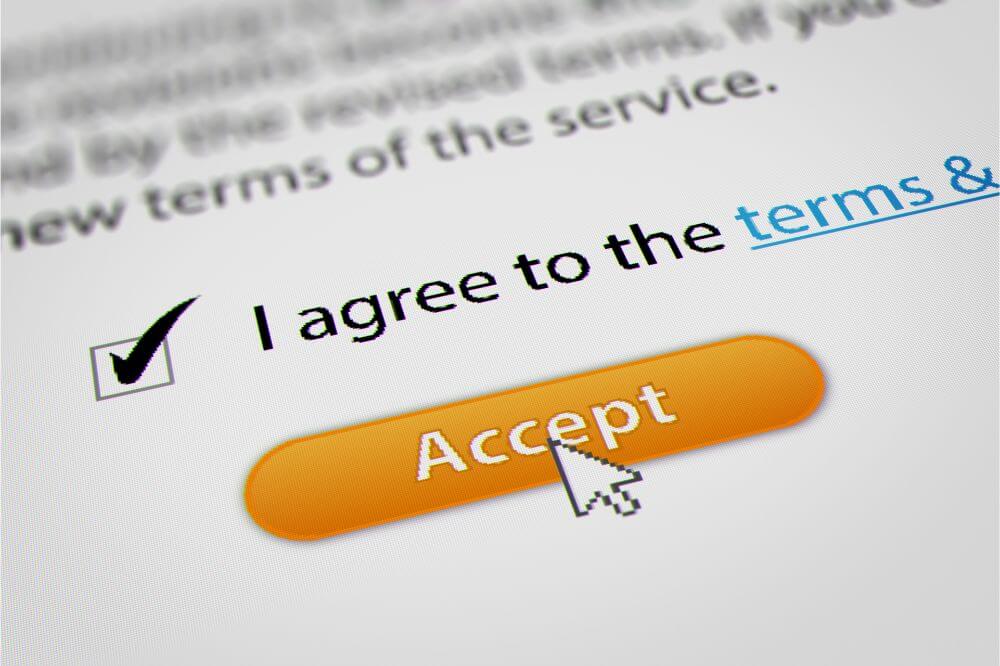Has anyone ever actually read the full online Terms and Conditions before clicking ‘I agree?’ Surely, it’s just one of those inconsequential pages every website needs to include due to some legal reason. You might as well copy the agreement from a different platform and focus on more pressing matters. Well, we’re here to dissuade you from that line of thinking. If you want to run a successful online business, you need to familiarize yourself with the website Terms and Conditions legal requirements.
A company’s web page is the gateway to potential customers, and it needs to be protected from any form of content abuse. Trust us; all it takes is one liability suit for your online business to end up in dire straits. To avoid that, keep reading to learn more about the keys to a solid Terms of Use agreement.
Terms and Conditions Overview
Let’s start with the basics: What does a Terms and Conditions agreement imply? Simply put, it’s a page on your website that outlines the user's rights and obligations. It establishes the legal framework for using a particular service or interacting with your web content in general.
The agreement may have different titles (e.g., Terms of Use, Terms of Service), but legally speaking, they all imply the same thing.

Basic Elements of Terms and Conditions
Although they may differ based on the purpose of the platform, Terms and Conditions usually contain the following elements:
Limitation of Liability
Also called a disclaimer, it absolves the website owner of liability in cases of factual mistakes or misinformation within the page that are not created by you. If you run a website that invites people to comment or contribute in any way, it’s a crucial element.
By adding a disclaimer to the Terms and Conditions page, you’ll have distanced yourself from any potentially offensive language and problematic content.

Copyright
Whether you own a dropshipping shop or run a knitting blog, you need to include a copyright notice on your website. The claim states you are the owner of all intellectual property, including the brand, the logo, and other trademark content. You need to make sure it’s up to date, meaning it covers the current year.
Statement of Governing Law
It's the part that includes the regional laws that stipulate the terms and conditions. It also describes any behavior that can be classified as abuse and the direct consequences of such actions.
Privacy Policy
You’re obligated to publish a privacy policy if your page requires the consumer to submit information, be it email addresses or credit card numbers. It’s probably the most legally binding aspect of the Terms and Conditions since it concerns personal data use and privacy rights. In addition, you need to include a cookies policy in the ‘Terms of Use’ if your website uses cookies.
Change Clause
As the site owner, you retain the right to amend or alter the Terms and Conditions at any given time. The clause ensures you don’t have to alert the site users when you wish to do so. However, most online businesses choose to send out emails or post an announcement saying that the Terms of Use have changed.
It’s safe to say these elements are the bare minimum of a standard Terms and Conditions agreement. As we mentioned earlier, the contents can vary significantly depending on the type of website you’re running. For example, e-commerce pages have a variety of other clauses in addition to the ones mentioned above:
Description Disclaimer
Many online shops include this as a formal statement. It means that while the owners make every effort to ensure all product descriptions are correct, they can’t guarantee they’re entirely error-free.
Returns and Refunds Policies
The part that describes the conditions for returns and refunds is a must for online shops. It determines who is responsible for postal charges on a return, when clients can request a refund, and other important information.
An assertion that prices that are valid at the time of publishing may fluctuate before the order.
You can have an attorney compose a terms and conditions policy for your online business, or you can simply download a template from online providers like Legal Template.

Reasons Why You Need Terms and Conditions
There are five key reasons why you should include the Terms of Use on your website:
1. Protection From Abuse
The Terms and Conditions serve as a legally binding agreement between you and your customers. Not only does it dictate the general rules and requirements, but it also describes what happens if your website or app is abused. Abuse may involve spamming other users, uploading defamatory posts, or trying to corrupt the website with malware, among other things.
2. Prevention of Copyright Infringement
You own the logo, the content, the design, and pretty much everything contained within your website. The Terms and Conditions validate your ownership and declare that international copyright laws protect your content. Of course, the exception is any content generated or uploaded by site users, but that should also be included in the agreement.
3. Limited Liability
A warranty disclaimer is meant to restrict the liabilities if the material posted on your website contains errors or is deemed offensive. Without it, you can be held accountable for any erroneous comment that shows up on the page. That’s why it’s considered one of the basic elements of a Terms and Conditions agreement.
4. Permission to Terminate Accounts
When you add this clause, you have the right to terminate accounts that violate the Terms of Use. It's there to warn visitors to your site that disrespectful accounts will be immediately removed and their access to the website permanently or temporarily revoked. The clause is intended explicitly for websites with a login section.
5. Declaration of the Governing Law
The Governing Law clause refers to the legislature that’s corresponding to the terms presented in the agreement. It’s important to point this out since the laws vary from state to state. For example, if your company is located in Washington state, the Terms and Conditions on your page should read as follows:
‘These terms and conditions are governed by the laws of the United States of America and the State of Washington laws.’

FAQ
Does My Website Really Need a Terms and Conditions Page?
The Terms and Conditions page isn’t required by law, except when collecting personal data. However, all websites need one since it serves as the legal foundation for the site's interaction with the customer. The agreement defends your rights as the website owner and restricts liabilities should legal action against you ever take place. A judge will look at the Terms of Use to decide whether there was a breach of contract on your part. That’s why, when designing the agreement, make it so it stands up in court.
In some cases, though, it’s an integral part of the website. For example, the Terms of Service on e-commerce platforms are mandated by consumer protection legislation. It usually provides details about the terms of sale, shipping, payment methods, withdrawals, and cancellation clauses, among other things.
How Do You Create Terms of Use for Your Website?
Despite their apparent simplicity, Terms and Conditions are designed to address very complicated and detailed situations. Since each agreement presents a legally binding contract, it must be tailored to your particular business model. That's why it's never a good idea to copy another website's Terms of Use page.
Luckily, there are several websites you can use to create a tailored Terms and Conditions document. By simply searching ‘terms and conditions generator’ on Google, you'll find a wide range of free online tools. It’s also a good idea to have a lawyer review the document, if possible.
A professional can ensure it satisfies the company's basic needs while protecting the website content. Small business owners, in particular, should seek legal guidance, especially if they're interested in e-commerce.
The great thing is several online platforms offer both document generation and legal aid. For a first-hand recommendation, make sure to keep reading.

How to Enforce Terms and Conditions?
We would say using the click-wrap or click-through form is the most effective option. A click-wrap document delivered in an obvious and consistent way presents solid evidence that you have reached an enforceable, contractual agreement with the site user.
Since the customer has ‘signed’ the document formally by pressing ‘I agree’ on the Terms and Conditions, the courts will usually deem it enforceable. There is, however, no assurance that the court can thoroughly enforce the Terms and Conditions.
How Often Should Terms of Use Be Updated or Reviewed?
As your business transforms, the website's Terms and Conditions should change as well. Anything can be a call for an update, from branching out to a different niche to cutting down prices.
You also need to keep up with the laws and regulations in your particular area and make sure the copyright claim is up to date. I’d say the page should be reviewed at least annually, preferably at the beginning of the financial year.
Does the GDPR Affect the Terms & Conditions of Your Website?
Terms of Use agreements are not covered by the GDPR (General Data Protection Regulation). However, there are several cases in which the new privacy laws have an indirect impact.
For instance, while the GDPR demands that Privacy Policies and Terms and Conditions be kept separate, the two documents are often linked. So, if you're changing your Privacy Policy, make sure to replace the link on the Terms of Use page with the updated document.
Where to Display General Terms and Conditions?
The general rule is to make the Terms and Conditions link easy to find. The font size should be at least the same as the surrounding text, preferably even bigger. Bonus points if the document is all capitals, bolded, and a different color from the surrounding text.
Also, make sure site users can access the agreement without having to scroll down the tab. It should be visible across the site, so either put it above the fold of the page or at the very top.
Top Picks for Online Legal Aid
As promised, here are some recommendations for a reliable online source for legal guidance. Apart from generating documents, these platforms also offer legal advice and other relevant services. After all, a lawyer's fee can get high, so it can’t hurt to look for a more cost-friendly solution.
LegalZoom
LegalZoom.com, Inc. is a platform that assists clients with creating legal records without the need for an attorney. Anything from wills and living trusts, to company incorporation papers, to patent registrations are among the available documents. In addition, the firm provides solicitor referrals and registered agent services. It's great if you don't have the resources to hire a lawyer.
Why We Like It
It saves both time and money.
RocketLawyer
RocketLawyer offers a network of experts you can collaborate with on various legal matters. The platform provides online legal advice to companies and individuals via their excellent On-Call service. If you run a small to medium-sized firm, they’re a top-notch choice.
Why We Like It
It takes care of the little guy.
Legal Nature
Legal Nature specializes in the automation of legal records and procedures. The founders' mission is to make the legal system easier to understand while providing affordable services. It’s perfect for website owners who feel out of their depth in trying to create a Terms of Use agreement.
Why We Like It
They explain everything in a way that is easy to understand.
US Legal Forms
US Legal Forms is one of the most successful legal document service businesses. Their customizable, legally binding forms, documents, and contracts have helped over 10 million businesses save an estimated 2 billion dollars in legal fees.
They provide over 85,000 legal forms that you can use in your online business such as partnership agreements, Non-Disclosure Agreement, Website Terms and Conditions, and many more.
Why We Like It
They have a massive library of legal documents you can use.
Coming to Terms With the Terms of Use
The website Terms and Conditions legal requirements are there to protect you from liability, copyright infringement, and other sticky situations.
You can tailor the agreement to your company’s needs with the help of dozens of online generators. There’s even a way to avoid paying the hefty attorney’s fee, thanks to platforms like LegalZoom, RocketLawyer, Legal Nature, and US Legal Forms.
All in all, site users can probably successfully navigate a website without going through the Terms of Use in detail, but website owners don’t have the luxury.
Sure, you’re not legally obligated to include the agreement on most pages, but why risk it? It's straightforward to set up and can be a saving grace in case of litigation. So, be smart and make sure your website is always on good terms (and conditions) with the law.


